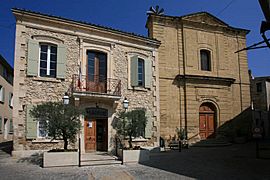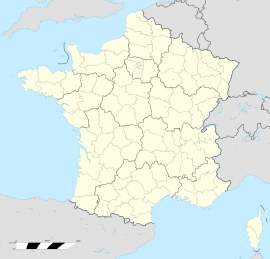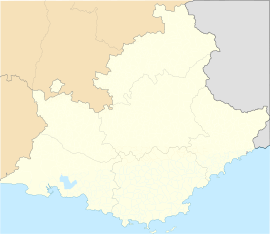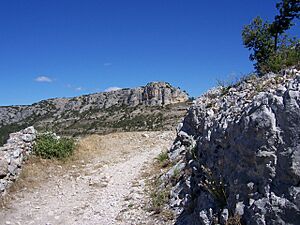Mérindol facts for kids
Quick facts for kids
Mérindol
|
||
|---|---|---|

Town hall and church in Mérindol
|
||
|
||
| Country | France | |
| Region | Provence-Alpes-Côte d'Azur | |
| Department | Vaucluse | |
| Arrondissement | Apt | |
| Canton | Cadenet | |
| Intercommunality | Provence Luberon Durance | |
| Area
1
|
26.59 km2 (10.27 sq mi) | |
| Population
(2006)
|
1,923 | |
| • Density | 72.32/km2 (187.31/sq mi) | |
| Time zone | UTC+01:00 (CET) | |
| • Summer (DST) | UTC+02:00 (CEST) | |
| INSEE/Postal code |
84074 /84360
|
|
| Elevation | 100–620 m (330–2,030 ft) (avg. 168 m or 551 ft) |
|
| 1 French Land Register data, which excludes lakes, ponds, glaciers > 1 km2 (0.386 sq mi or 247 acres) and river estuaries. | ||
Mérindol is a small town, also called a commune, in the south of France. About 1,923 people lived there in 2006. It is located in the Provence-Alpes-Côte d'Azur region, within the Vaucluse department.
The weather in Mérindol is like the Mediterranean. Summers are hot and dry, while winters are mild. It does not rain very often, and snow is quite rare. The town is protected by the Luberon, a nearby mountain range. This helps shelter it from the mistral, a cold, dry wind that blows from the north.
Mérindol was first built on a hill. This made it easy to defend against attacks. After the town was destroyed in 1545, it was rebuilt on the flat land below, close to a river.
Mérindol's Past
A ferry boat was used to cross the Durance River near Mérindol as early as the year 1240. The town was later left empty, probably because of a terrible sickness called the plague, during the 15th century.
Later, in the Middle Ages, a ruler named Louis II of Provence sold the land. New owners brought in farming families from a region called Piedmont. These farmers followed the teachings of Pierre Vaudes, also known as Peter Waldo. They were part of a group called the Vaudois or Waldensians. This group had separated from the Catholic Church around 1170.
The Waldensians believed in living a very simple life. They based their beliefs on a line from the Gospel of Matthew in the Bible. This simple way of life was very different from the rich and powerful church of the time.
In 1530, a priest named Jean de Roma started a campaign against the Waldensians. He claimed they were "heretics," meaning their beliefs were wrong. His groups attacked the town, burning many houses and harming many people.
In 1540, Jean de Roma arrested a flour miller from Mérindol. He took the miller's mill and then had the man executed. On November 18, 1540, nineteen more people were sentenced to death. The town was also ordered to be completely destroyed.
A group from Mérindol went to the king to ask for help. The king gave them until 1545 to change their religion and rejoin the Catholic Church. However, on April 18, 1545, the village was completely burned. Some of the Waldensians still living there were killed. Over one week, eleven other small villages were attacked. Many people were killed during these attacks. Many Waldensians from Mérindol managed to escape and found safety in Switzerland.
Remembering the Past
In 1977, groups of Waldensian people from Germany, France, and Italy worked together. They built a special path to remember those who were killed for their religious beliefs. This path leads to the old ruins of the Waldensian church.
Want to Know More?
 In Spanish: Mérindol para niños
In Spanish: Mérindol para niños





